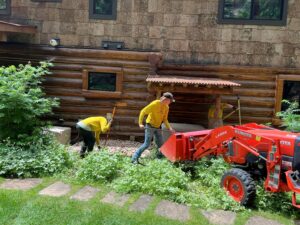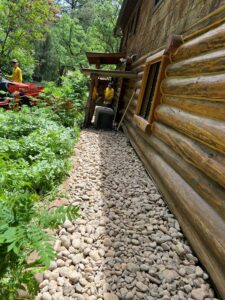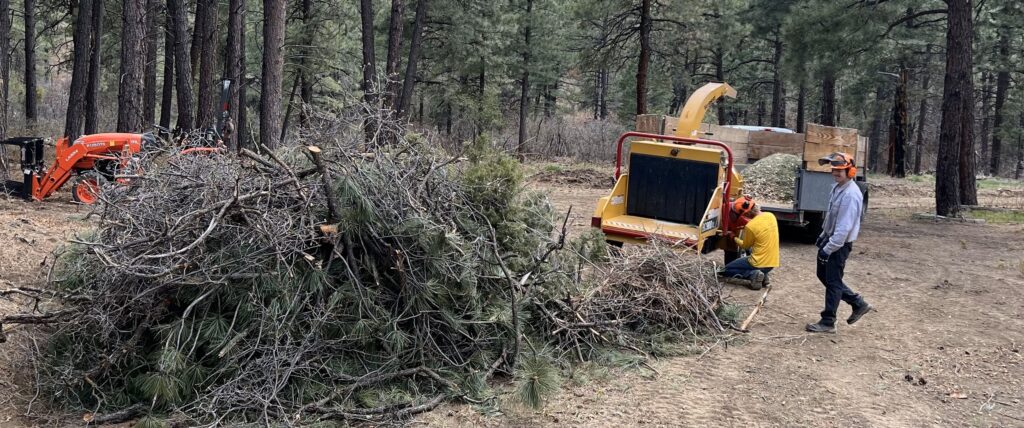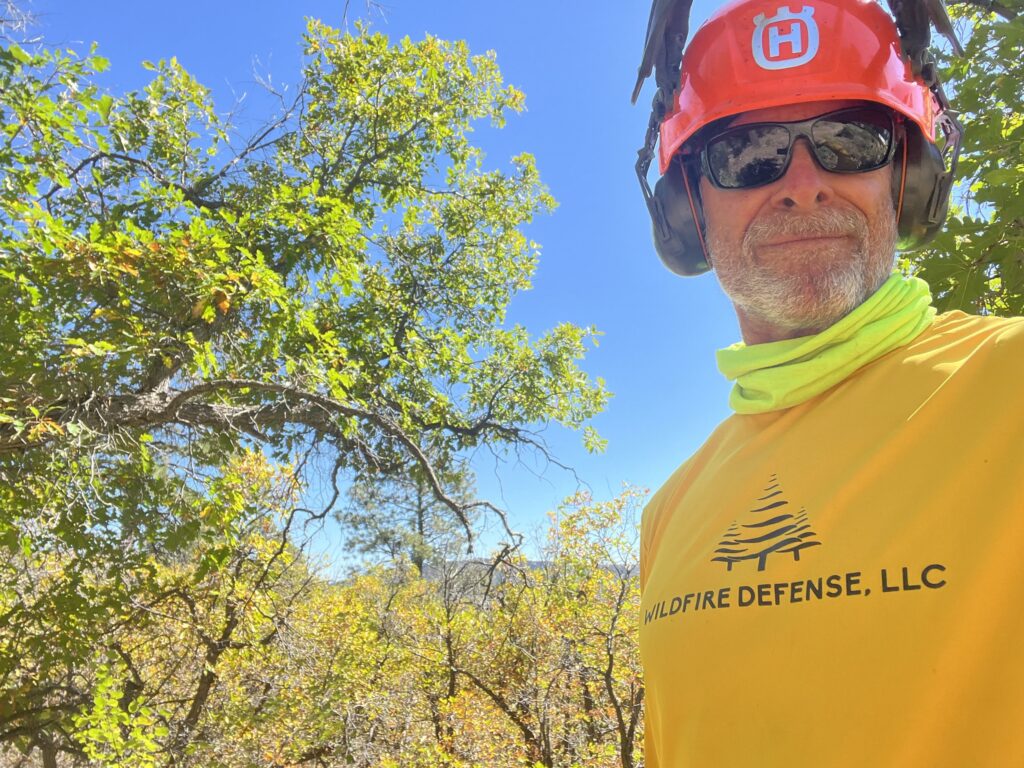Wildfire Defense's Terry Hunt Shares How Burnout Led to Burn Down Prevention
Embers fly from tree to tree like songbirds seeking new nests. One searing sparrow swoops down to a house below the canopy. It ignites the ornamental shrubbery spanning the walls. Soon, the house disappears behind giant wings of glowing apricot and saffron.
This is the nightmare scenario homeowners dread, especially in and around Durango where homes have been snuggly nestled into the scenic forests where devastating wildfires can erupt. The risk is especially high this summer, notes Terry Hunt, founder of Wildfire Defense, LLC, a family-owned and operated company devoted to defending homes in Durango, Bayfield, Mancos, Hesperus, and Pagosa Springs from wildfire destruction.
“We’ve already had three or four red flag days,” Terry grumbles. “And that was before the official start of summer two or three days ago.”
 Wildfire Defense (WD) provides comprehensive and thorough wildfire mitigation by removing vulnerabilities from the area around the home, referred to as its defensible space, as well as by applying practical fire-resistant alterations to the house, or “home hardening.” WD is currently the only wildfire mitigation contractor offering both prevention methods. Having worked in wildfire mitigation since 1978, Terry knows all too well that one defense without the other is irrational. “You’re addressing only one half of the equation,” he notes.
Wildfire Defense (WD) provides comprehensive and thorough wildfire mitigation by removing vulnerabilities from the area around the home, referred to as its defensible space, as well as by applying practical fire-resistant alterations to the house, or “home hardening.” WD is currently the only wildfire mitigation contractor offering both prevention methods. Having worked in wildfire mitigation since 1978, Terry knows all too well that one defense without the other is irrational. “You’re addressing only one half of the equation,” he notes.
Think of it like sending a knight into battle with a sword but no armor or vice versa—all armor and no sword.
He notes, “All the recent forensic evidence that’s come out—it all shows predominantly that homes catch on fire due to embers as opposed to direct contact with a wildfire.” He points to February’s devastating L.A. fires as a prime example where homes three miles away from the actual blaze ignited because of embers blown to them on the wind. “There’s a lot to be said for the home hardening part of it.”
Terry’s path to preventing homes from burning down began with his own burnout. At age 21, he took a hiatus from college where he was on a pre-med track to become a doctor. “I couldn’t stand being cooped up indoors. I decided that working outdoors was where I was happiest,” he says. Terry fled to California’s San Bernardino Forest. “I initially got a job working in a lumber yard. And then while working there, I met guys who were working in forestry and [eventually] went to work with them.”
From Almost-Doctor to Mr. Hothead
Since then, Terry has amassed an unparalleled expertise in wildfire mitigation. One could say he has a hot head on his shoulders. He is one of the few NFPA-certified Wildfire Mitigation Specialists in Southwest Colorado. He has been asked to make wildfire education presentations for the La Plata County Wildfire Advisory Board and State Farm Insurance, and teaches a CE-certified wildfire mitigation and insurance in fire risk areas for the Durango Area Association of Realtors.
What’s the primary blind spot he encounters in the public’s grasp of wildfire risk? Most people do not realize they live in the Wildland Urban Interface, or WUI (wooey). The WUI is any place where human development mingles with natural forests, grasslands, and shrublands.
To illustrate this point, Terry again points to the L.A. fires earlier this year where people all across the vast city had no clue they lived in a WUI and were susceptible to wildfire destruction until winds chased fires down canyons and directly into dense neighborhoods. Terry exclaims, “Lifeguard towers were catching on fire! They are on sand!” But even that beach sand is part of the WUI.
 WUI awareness is spreading from properties on the outskirts to homes situated in town in part because insurance companies are supplying a stinging wake-up call. According to Terry, notices of coverage cancelation are trickling into people’s mailboxes and inboxes as homeowners are given a couple months to address the chinks in their home’s wildfire armor. Although he has primarily worked on acre-plus properties out in the woods, Terry has seen a recent uptick in calls for mitigation in town.
WUI awareness is spreading from properties on the outskirts to homes situated in town in part because insurance companies are supplying a stinging wake-up call. According to Terry, notices of coverage cancelation are trickling into people’s mailboxes and inboxes as homeowners are given a couple months to address the chinks in their home’s wildfire armor. Although he has primarily worked on acre-plus properties out in the woods, Terry has seen a recent uptick in calls for mitigation in town.
Because fire danger is at an all-time high, WD will waive its $400 fee for a mitigation assessment. That means, for free, Terry will walk through a property with a homeowner and highlight all the areas where the home is vulnerable or the minutiae that an insurance inspector will look for.
Terry moves meticulously from the top of the house to the bottom and then outward, zone by zone, from five to 10 to 30 and to 100 feet out. He’ll inform homeowners how to DIY the home hardening retrofits and the defensible space alterations. Alternately, WD’s four-man and one-woman crew can take care of the mitigation to-do list.
The Frozen Pizza Fire Phenomenon
“We generally like to start off with the defensible space, just to get that out of the way, and then work into home retrofits,” Terry explains. That means, they remove low-level limbs from trees and thin out tree clusters and underbrush around a home. The goal is to reduce a fire’s fuel and kneecap its ability to sweep continuously across a space. The team is also looking for ways to draw fire out of the tree canopy and to the ground where it will starve and snuff out. Finally, they want to reduce a fire’s ability to generate excessive radiant heat.
“If you have a wood exterior siding, wood can catch on fire at 400 degrees—just from radiant heat!” Terry explains. In other words, your home can combust when exposed to the same temperatures your oven generates to cook a frozen pizza.

But all that brush- and tree-clearing produces a lot of waste, or slash. In a typical week, WD can easily accumulate some 4,000 cubit feet of branches, trunks, and wood chips. That’s enough to fill a standard railcar! Previously, WD faced a logistical nightmare when trying to relocate the woody waste until Table to Farm Compost opened its doors out on the farm. After all, making great compost demands lots of woody carbon matter.
Terry attests, “We appreciate Table to Farm! Without them, we would be hard-pressed to find another site to bring all the forest fuels slash produced from our mitigation efforts in and around the Durango area.”
After tackling the defensible space, the WD crew attends to a home’s retrofits. Perhaps the term “retrofit” evokes a panic-laden kah-ching chime of a cash register? Terry points out that these fixes do not necessarily burn a hole in your pocket. Screening over vents and under decking are two simple ways to shore up a home’s fire defense. He and his team also establish a stoney “moat” around the immediate perimeter of the home and relocate ornamental—and flammable—landscaping outside the moat.
“When done right,” Terry says, “wildfire mitigation reduces the risk of losing your home and property to wildfire.” If you think of wildfires like diseases, then Terry did kind of become a doctor who has spent a lifetime applying the patches and preventatives that preserve human life and wellbeing.
After five decades of confronting wildfire dangers, Terry has realized that his somewhat haphazard career switch has brought him so much more than the satisfaction of working outdoors. He confides, “I really like helping people. I always have.”

